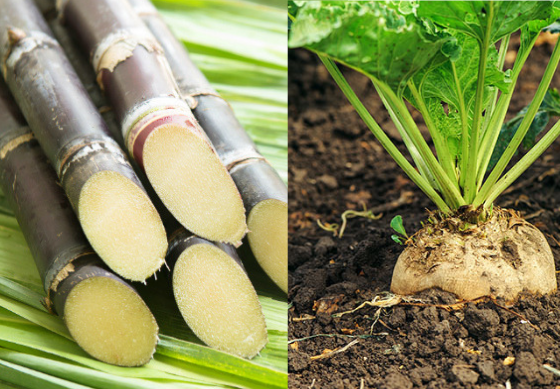Producers consider beet sugar vs cane sugar when choosing sweeteners for different confectionery items.
Checking Out the Differences in operation and Benefits In Between Beet Sugar Vs Cane Sugar
In the culinary world, the selection between beet sugar and cane sugar is not simply about sweet taste but includes a nuanced factor to consider of flavor, application, and effect. While both sugars stem from various plants, each undergoes distinct manufacturing procedures that subtly affect their qualities and viability for numerous dishes.
Origins and Production Procedures of Beet and Cane Sugar

Walking cane sugar, on the various other hand, comes from the sugarcane plant, an exotic lawn indigenous to Southeast Asia but now cultivated in exotic areas worldwide - beet sugar vs cane sugar. The manufacturing of cane sugar begins with the harvesting of cane stalks, which are squashed to launch the juice.

Nutritional Material and Health And Wellness Considerations

When comparing the nutritional material of beet sugar and cane sugar, it becomes obvious that both types essentially offer the very same calorie values, with about 16 calories per teaspoon and no substantial nutrient variety. Each is composed nearly totally of sucrose, which is a basic carbohydrate that provides quick power yet does not have vitamins, minerals, or fiber. This similarity encompasses their effect on health and wellness, specifically worrying blood sugar levels. Both sugars, when consumed over, can add to elevated blood glucose degrees, a threat variable for diabetes and other metabolic disorders. Furthermore, extreme consumption can lead to weight gain and dental problems, as both sugars are equally cariogenic, promoting dental cavity. From a wellness viewpoint, regulating consumption of any type of kind of sugar, whether from beet or cane, is a good idea to prevent these prospective negative effects on well-being. Hence, neither holds a distinct advantage over the other in terms of wellness advantages.
Taste Profiles and Culinary Applications
Despite their comparable chemical structures, beet sugar and cane sugar vary discreetly in flavor, which can affect their use in numerous culinary contexts. Cane sugar often lugs a hint of molasses, also in its refined type, lending a cozy, caramel-like undertone that boosts baked products, coffee, and chocolate-based recipes. This minor molasses flavor is specifically valued in the baking market for adding depth to desserts and pastries. On see here now the various other hand, beet sugar is characterized by its very refined, neutral taste, making it a functional sweetener that does not change the flavor profiles of recipes. This neutrality is especially helpful in fragile recipes, such as light breads, creams, and some sauces, where the intrinsic flavors of various other active ingredients are meant to stand out. As a result, cooks and food manufacturers may pick one sort of sugar over the other based upon the preferred flavor result of their cooking productions.
Ecological Impact and Sustainability
While both beet and cane sugars are originated from plants, useful source their environmental effects differ substantially because of the distinctive methods of cultivation and handling needed for each and every. Sugar beet farming usually entails considerable automation, which can raise fossil gas intake and carbon discharges. Beets can be grown in cooler environments and call for less watering, possibly decreasing water usage contrasted to sugarcane. Sugarcane, on the various other hand, is normally grown in tropical areas where it depends heavily on watering and a longer growing period, increasing its water impact.
Moreover, the handling of sugarcane typically produces a substantial amount of waste, including bagasse, which, although usable as biofuel, regularly adds to air contamination if burned inefficiently. Sugar beet processing makes use of more of the raw materials, leading to less waste. Both sectors face challenges in minimizing their ecological footprints, however ongoing innovations in agricultural techniques and waste administration are intending to improve sustainability.
Economic Factors Influencing the Sugar Sector
The financial characteristics of the sugar market are substantially affected by worldwide market demands and profession policies. In regions where sugarcane or sugar beet production is subsidized, producers might have an economic benefit that allows them to use lower prices on the global market.
Additionally, variations in international need for my blog sugar, affected by nutritional fads and commercial use in food products, straight influence costs and production degrees. beet sugar vs cane sugar. Weather additionally play a crucial duty, as they can significantly influence crop yields and, subsequently, the supply chain. This irregularity introduces a degree of financial uncertainty that can lead to financial investment volatility in sugar production sectors, influencing choices from growing to market technique
Conclusion
To conclude, both beet and cane sugar have special qualities that match different cooking requirements. While cane sugar imparts an abundant flavor perfect for improving baked items, beet sugar's neutrality is excellent for lighter meals. Nutritional resemblances notwithstanding, their distinct manufacturing processes and environmental impacts add intricacy to the option in between them. Hence, comprehending these distinctions helps cooks and consumers make educated decisions that straighten with their health and wellness, cooking, and ethical choices.